Making my way slowly through this last season’s episodes of Searching for Italy. I have to say, I’m finding it less interesting than the first season. It feels a little bit like Tucci lost interest in really talking to the people who he was meeting – we’re getting less about them and more about him. Celebrity pitfall I suppose. The second episode of the second season, he heads to Piemonte. And also the small state of Val d’Aosta, but the near hour-long show spends maybe seven minutes on the entire state, and more or less writes off its cuisine as derivative of neighboring France and Switzerland and not very Italian and therefore not very interesting. Mostly he just drank some local liqueur, and made sarcastic comments about the cuisine and people, while visiting a mountain panorama lookout.
This is going to be, perhaps, an odd post in the way I approach it. There were two dishes that he actually had someone demonstrate. The first one is so basic that I felt like I had to do the second one. Both, interestingly, are inspired by traditional local dishes, but neither is done in a traditional manner. So I did a little filling in….
Bagna Cauda, the hot bath, is traditionally a mix of olive oil and butter infused with garlic, anchovy, and truffle (when available and/or affordable). It’s used sort of like a fondue – you dip raw vegetables and bread into it and snack. Tucci visited a small family run restaurant, Piola di Celso, in Torino, where they definitely approach this dish in a different way. I’m making both, side by side, because the traditional is a long time favorite, and just to show both versions. So I’ve got garlic and anchovies, and some white truffle oil. On the left, the classic olive oil and butter, on the right, milk.
In the classic, you bring the olive oil, truffle oil, and butter, to a simmer (okay, really traditional, some grated truffle rather than truffle oil, but, we’re not going there for a snack), with the garlic sliced into it. Before the garlic browns, but when it’s gotten soft, you add in the anchovies and sort of mash them around until they fall apart. Take the whole thing off the heat, keep warm and serve.
In the Celso version, she poached chunks of garlic in the milk until soft, then added a lot of anchovies. Actually, far more than I did, but I used an entire jar, and wasn’t about to open another. Just wanted to get a sense of the dish. She then passes it through a food mill. I know I have one in a closet somewhere here at home, but didn’t go digging for it, instead just giving it a few pulses with the stick blender (or a food processor). It creates a sort of sludgy paste – which is exactly what it looked like in the show (hers was darker brown, from the larger quantity of anchovies). There wasn’t a whole lot appetizing about the look of it, either in the show or at home.
And serve with raw vegetables and bread if you want. These aren’t necessarily the traditional choices of veggies, but what I had on hand.
So what did I think? I love, as always, the classic. It just bathes the vegetables in garlicky, slightly salty from the anchovy, with a hint of earthiness from the truffle, flavors. What’s not to love about that? The show’s version… I hate. I really just didn’t like anything about it, from the texture, to the overwhelming intensity of both garlic and anchovy, particularly the latter. For me, bagna cauda is about flavoring the vegetables and enjoying them, whereas with this “dip”, you could be serving anything dipped into it, the flavor of the vegetable or bread is just lost.
Let’s move on to the second dish. Tucci visits with the Costardi brothers, Christian and Manuel, who have a small, one Michelin-starred restaurant attached to the Hotel Cinzia, in Vercelli, a city of about 45,000 people. The brothers are famous for their dedication to risottos, both traditional and creative, and along with other dishes, they offer around two dozen different ones. The risotto featured in the show was flavored with beer, coffee, and grana padano cheese.
This risotto isn’t remotely traditional, but it sounded fascinating, as does the restaurant. So we have carnaroli rice, grana padano cheese (cow’s milk, from Emilia-Romagna, aged similar to parmesan, but with a unique flavor), cream, beer (I used dark beer, because it seemed to make sense, but visually, later, thinking about the show, I’m pretty sure they used something much lighter), espresso, celery, onion, carrot. Not shown, a large pat of butter.
Quick vegetable stock. Coarsely slice up the onion, carrot, and celery, into a pot with water, some salt, and a few peppercorns. Bring to simmer and cook for about thirty to forty minutes. Strain, adjust seasoning, and keep hot.
The brothers stated in the show that they simply reduced the beer until it was syrupy. Theirs, as I said, was much lighter in color in the final syrup. I also found that while certainly thicker than it started out – one can of beer reduced to about three tablespoons, it wasn’t quite what I’d call syrupy. Something tells me they add something to it to give it the more molasses-like character it had in the show’s presentation.
If you’ve been following my recent “Roman pastas” posts, you’ve been introduced to the way to prevent grated cheese from clumping and getting stringy. I grated the grana padano, then added a couple of tablespoons of the hot vegetable stock, and whisked it into a paste. I heated the cream to just starting to bubble, then removed it from the heat (again, important step!), and whisked in the cheese paste.
I’ve never seen or made a risotto like this, but it’s intriguing, and I kind of like how it turns out. They put the rice into a dry skillet, and toast it over low heat, for a good ten minutes, stirring it up now and again, until it gets lightly golden. The aroma reminded me almost of making popcorn. You then start adding in the stock, stirring regularly – I covered the step-by-step and reasons for each step in my last Tucci post. When the rice is cooked a perfect al dente, whisked in a little cold butter to give it some richness. I’m actually not sure they did that in the show, they mentioned the “mantecada”, but then immediately talked about the grana padano cream sauce, almost like they were keeping the ideas separate. Not sure.
In the restaurant, they serve this risotto layered in a sort of knock-off Campbell’s soup can. You can’t even see what you’re being served, other than the top surface. I didn’t need to go out looking for soup cans. So, a good drizzle of the beer syrup, topped with a ladle of the risotto, coated with the grana padano cream, then a little more drizzle of the beer syrup, and a scattering of the espresso (they make a point that they use Lavazza, but I imagine that was more promotional than anything else).
I like the dish. I don’t love it. Obviously I’m guessing at some of what they do, and it’s probable that their version is far more delicious than mine. They do have a Michelin star after all, and they claimed this is one of their most popular risottos. Would I make it again? Probably not, but some of the ideas, particularly the heavy toasting of the rice, and the grana padano cream sauce, will likely work their way into my repertoire.
And, all dishes paired off with a local Nebbiolo based wine, the primary grape of Piemonte, the foundation of Barbaresco and Barolo. This one from Familia Cecchin, in the Maipú region of Mendoza. I knew I had it on my wine rack, I didn’t realize that it was a 2002. Still vibrant fruit, soft, not really feeling like it’s a twenty year old wine. Impressive drinking, and I happily did so with my bagna cauda and risotto.
Next time, Tucci’s off to Umbria, in central Italy.
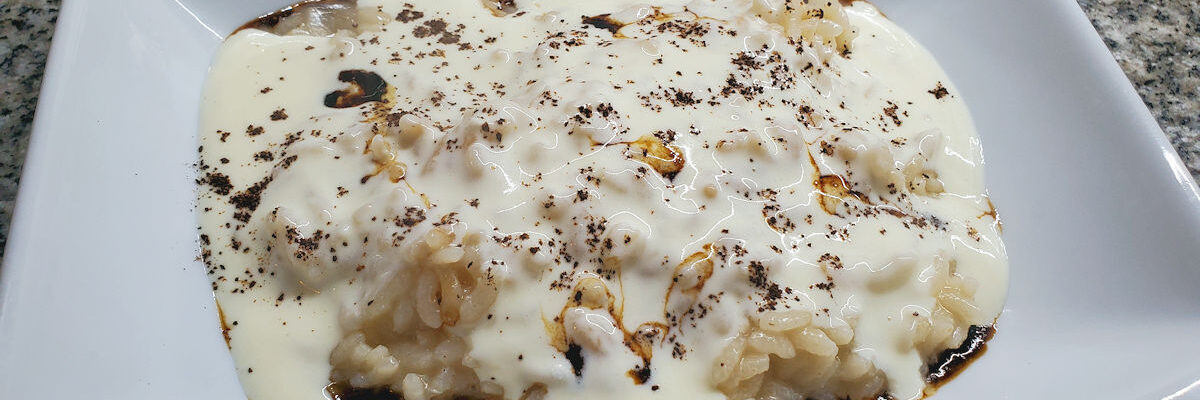
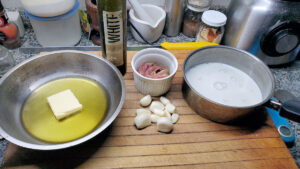
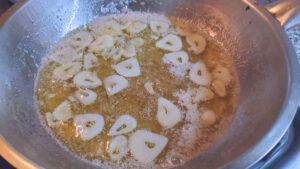
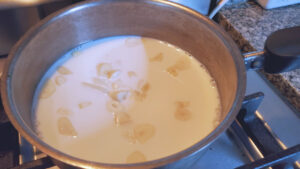
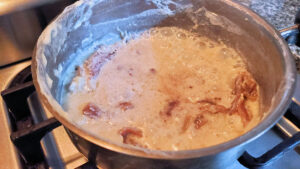
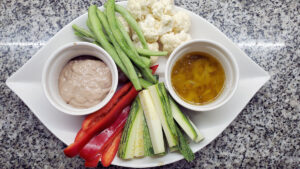
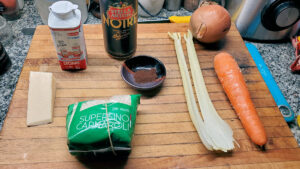
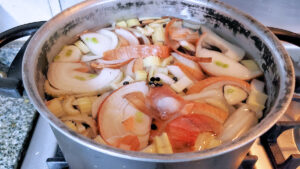
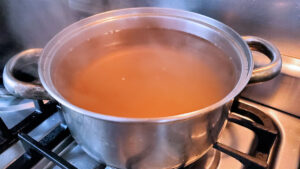
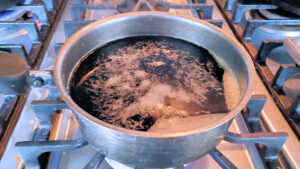
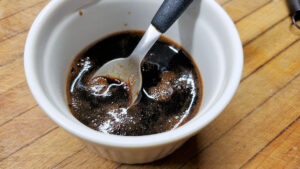
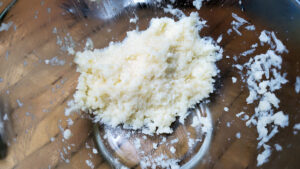
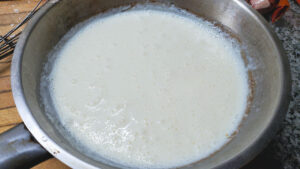
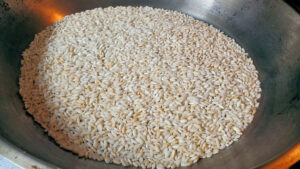
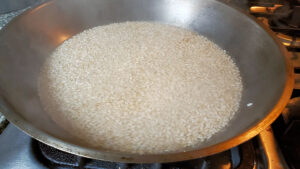
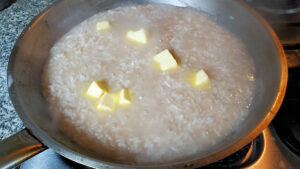
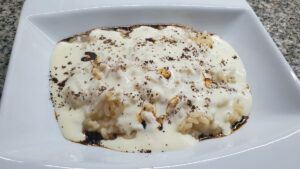
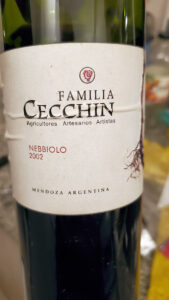
[…] toast the carnaroli rice, dry, the way presented in the Piemonte episode of Tucci’s series, because I like that slight nuttiness that comes out. And, in […]